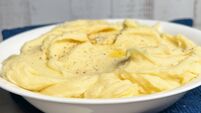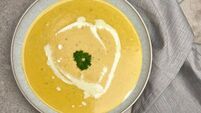The Currabinny Cooks: How to cook from the pantry

We have bought quite a lot of groceries lately, now that there seems to be a far greater variety of places open other than the supermarkets. We were determined to make sure to use up as much of what we excitedly bought as possible.
At the start of the week we came across a lovely fish mongers, recently open. We bought two lovely fillets of plaice, which is a fish we are both fond of. Flat fish tend to have that wonderful balance of incredibly light flaky flesh with an almost buttery flavour.
In a good neighbourhood butchers, we got some top quality Irish pork mince, which is actually very hard to find in a supermarket, but which is infinitely useful.
We also picked up a humble bag of little Irish heritage potatoes of an unnamed variety, but which seemed young and firm.
In our freezer, amongst other long forgotten things, were numerous packets of frozen peas, some gyoza dumpling wrappers and a tub of very good vegetable stock, made in the cold of winter and frozen for another time.
In an a very good Asian market near our home we picked up a large white Chinese cabbage, some long thin scallions, ginger and a jar of Indonesian sambal oeleck, which is the ultimate crushed chilli sauce for the brave.
These are the ingredients which ould form the basis for the week’s recipes. We made little pork and cabbage dumplings with a delicious dipping sauce, spiked with samba oeleck. We ate them with chop sticks on the stoop of our house, enjoying the lovely weather.
For dinner we had our plaice, cooked simply on the pan with lots of peas and for texture a lemony toasted breadcrumb. We made an unctuous little side dish with the potatoes, cut into hockey pucks and made into a sort of stove top dauphinois.
After all that, we still of course have an overflowing glut of ingredients waiting to be turned into delicious meals. Tune in next week for more…
Pork & Cabbage Dumplings
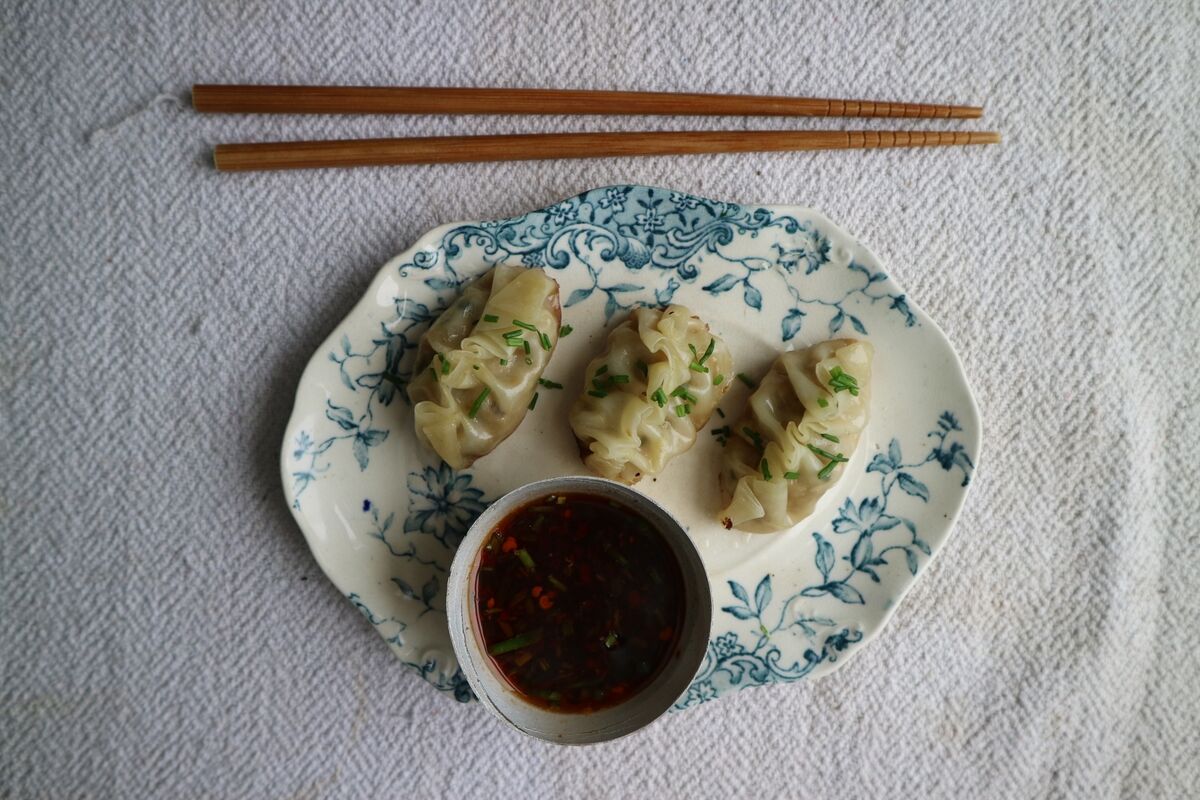
As sharing foods go, Japanese dumplings are definitely our go-to.
They can be a little fiddly to make at first, but once you get the hang of it the process becomes quite enjoyable, especially with the anticipation of delicious snacking at the end of it. You can pick up little ‘gyoza’ wrappers in the frozen section of most Asian food stores and some good speciality food stores. We usually just pop them from the freezer into the fridge the night before we use them, where they defrost gently and you don’t risk them turning soggy.
They are very thin little pancake shaped discs, which turn translucent and sticky when wetted.
The filling of pork and cabbage is the traditional go to, but feel free to play around. Ingredients like kimchi, beef, shrimp and mushroom all make excellent dumplings.
The dipping sauce is basically a mix of rice wine vinegar, soy sauce, sesame oil and some sort of spicy chilli sauce.
2 handfuls of shredded Chinese cabbage
6 spring onions, white parts only, sliced thinly
3 garlic cloves, crushed
2 teaspoons of freshly grated ginger
250g minced pork
Small handful of chopped chives
A splash of soy sauce
A pinch of salt, pepper & sugar
20 dumpling wrappers
2 teaspoons of sesame oil
Vegetable oil for cooking
100ml or so of water
1 tablespoon of sesame oil
100ml rice wine vinegar
2 teaspoons of chilli sauce
2 tablespoons of soy sauce (dark)
2 teaspoons of sugar
Place all the ingredients for the dip in a small saucepan and bring to the boil, allowing the sugar to dissolve.
Take off the heat and leave to the side to cool.
Place the shredded cabbage in a colander and sprinkle generously with salt which will help it release excess moisture.
Leave for around twenty minutes before squeezing the cabbage with your hands to release even more moisture.
Place in a bowl along with the pork mince, sliced spring onions, crushed garlic, grated ginger and season lightly with black pepper. Add the mixture to a frying pan over a medium low heat with a little sesame oil. Fry till the pork has turned pale.
Add the chives, soy sauce and sugar, mix through and take off the heat. Leave to cool.
Set up a little dumpling assembly station in your kitchen. You will need your defrosted gyoza wrappers, a little bowl of water, your cooled filling mixture and somewhere to place the dumplings when you make them.
Take a dumpling wrapper and place a heaped teaspoon size ball of the filling in the middle. Dip your fingers in the water and wet the edges of the dumpling wrapper.
Fold the wrapper up, with the filling in the middle and pinch close with your fingers, making a little pouch.
Crimp the dough with your fingers, making sure they are properly sealed. Repeat until you have 20 or so dumplings.
Heat a little vegetable oil in a shallow pan and fry the dumplings, until the bottoms have coloured lightly. Be careful not to let them stick. Pour around 100ml of water into the pan and cover with a lid. Leave for around 5 minutes, remove the lid, allowing the water to evaporate and remove the gyoza from the pan. Serve with the spicy dip.
Pan-Fried Plaice with Peas
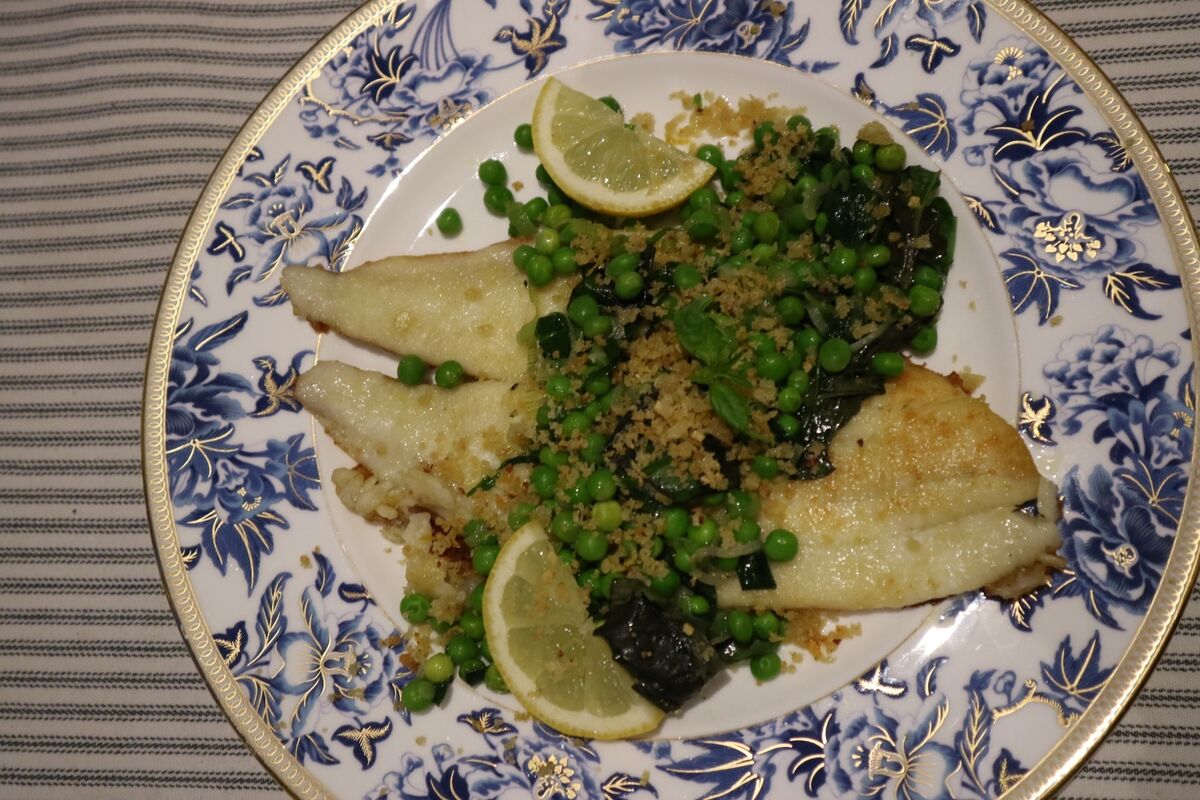
Plaice is probably the most common flat fish sold in this country. Try and get locally caught plaice in a good fishmongers and get them to fillet them for you. For this dish we usually serve them without the skin so you can get the fish monger to do that too if you wish. If you can’t find plaice then something like lemon sole would be just as delicious.
4 fillets of plaice, skinned
100g frozen or fresh peas
Handful of fresh basil leaves
6 spring onions, sliced thinly
100 of vegetable stock
2 tablespoons of olive oil
Sea salt and black pepper
1 tablespoon of cream flour
40g butter
Lemon wedges to serve
2 tablespoons of fresh white breadcrumbs (we like to use stale ciabatta)
1 teaspoon of olive oil
1/4 teaspoon of lemon zest
Pinch of dried chilli flakes
Make the toasted breadcrumbs by mixing the ingredients together in a small bowl and then transferring them to a small frying pan, moving them around in a medium hot pan for a couple of minutes until the breadcrumbs turn crunchy and golden. Remove from the heat and set aside.
Place the butter along with the spring onions, peas, basil, vegetable stock and olive oil in a sauce pan and season with sea salt. Bring to the boil and them reduce the heat, leaving to simmer for 3 minutes.
Pat the fish dry with some kitchen towel and them dust with the flour, seasoned with sea salt. Heat a little oil in a frying pan and add the fish, cooking on a medium high heat for 3 minutes on each side.
Serve the plaice with the peas and spring onion mixture spooned on top and garnished liberally with the toasted breadcrumbs.
Stove Top Dauphinois
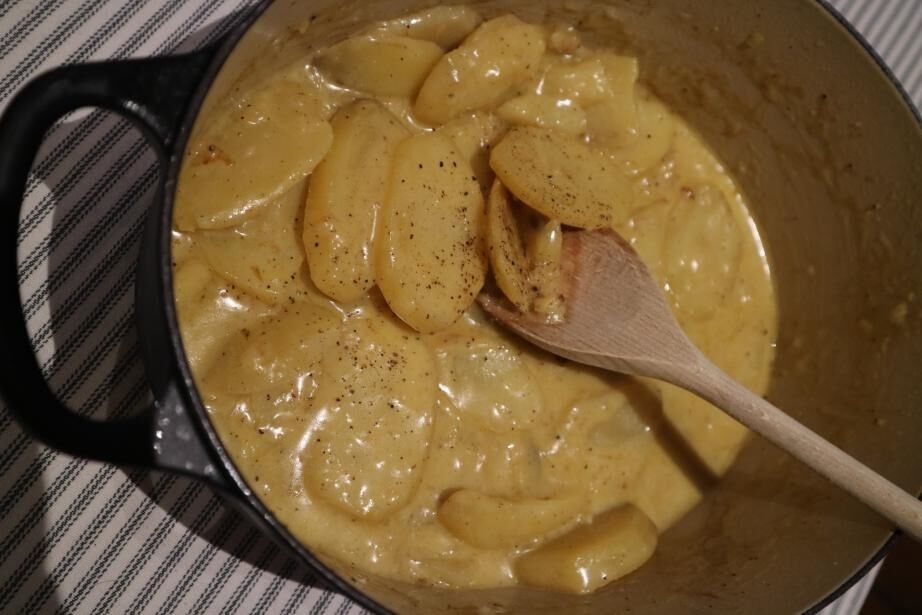
This is just a really simple way of recreating the deliciously decadent potato dauphinois or grain which is usually made in a hot oven.
This is a loose version which is made on the stove top but with great results for those short of time and patience.
3 shallots, finely sliced
3 cloves of garlic, finely sliced
1kg potatoes, peeled and sliced
100ml of white wine
500ml of vegetable stock
60ml cream
Melt the butter in a large saucepan or casserole and add the shallots and garlic, cooking over a medium high heat. Stir constantly until soft but not coloured. Add the potatoes and stir for a further 2 minutes.
Add the white wine and the stock, bring to the boil and cover.
Reduce the heat to a simmer and cook until the potatoes are tender, about 12 minutes.
Remove the lid and pour in the cream, cooking for a further two minutes.
Serve as a side dish.
